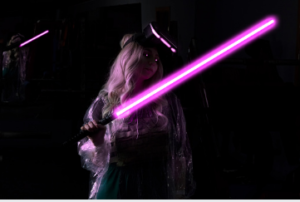Lightsabres are powerful swords capable of cutting through anything imaginable – blast doors and enemies alike! Although fictional weapons, Lightsabres remain very popular with fans of all ages.
 How Does A Lightsaber Work?
How Does A Lightsaber Work?
Blade
The blade of a lightsabre Saber Force collection is its most important asset, capable of cutting through blast doors or enemy swords without breaking or deflecting blaster bolts. Additionally, its programming allows it to deflect incoming blaster bolts while its hilt has been designed to resemble that of a knight’s or samurai’s sword to connect Jedi with warriors from bygone eras more closely.
The lightsabre’s blade is powered by a diatium power cell and crystals that focus the energy into a beam. These crystals are housed within a focusing crystal activator which connects directly to a blade energy channel and cycling field energizers for operation.
This setup produces both the plasma blades that light up and cut materials and the force-sensitive channel connecting Jedi essence with their sabres to use the Force. A Jedi’s level of experience and Force sensitivity was once linked with the colour of the sabre, now determined by which Kyber Crystal it bonds with. Kyber Crystals occur naturally on Ilum, while younglings visit the sacred Jedi-controlled Crystal Cave to locate their crystal as part of an initiation rite of passage ceremony.
Hilt
A lightsabre’s hilt, or body, is its core component. It houses its power cell or energy core and its focus ring and blade emitter – key elements for its operation when activated – along with aligning or controlling its Kyber crystal to produce its distinctive blade when needed. Without these essential pieces functioning together properly, no lightsabre would exist!
Hilts vary in length, width and weight depending on their user’s preferred choice. For instance, Count Dooku preferred using a slightly longer hilt that fit his curved fighting style more comfortably, while Kylo Ren preferred one with crossguard design features.
Hilts may come in any colour; Jedi commonly prefer green or blue for theirs. Conversely, Sith such as Darth Maul and Revan typically favour red-bladed sabres to symbolize their dark views of the Force.
Realistically, wielding a lightsabre Saber Force collection requires considerable strength. Blue Monkey Sports estimates that full-length standard-length hilts could weigh 11 pounds! That’s quite heavy, even for Yoda to wield in combat. Everyone must find the appropriate hilt size based on height, hand size and fighting style.
Controls
Operating a lightsabre requires access to vast energy reserves. This energy comes from diatium power cells – small devices smaller than coins – containing diatium power field conductors and vortex rings, which direct any available energy directly into its crystal energy chamber.
To set the sabre’s music mode, hold down its button while it is off (in sleep mode). After it flashes twice, press it again to turn it on and select your sound font and music font, after which your sabre will cycle through available formats of the sound font.
To adjust the sound volume on your lightsabre, hold down its button while it flashes three times, and it will cycle through all available volume settings. It doesn’t impact Blaster Blade or Ghost Blade modes or its blade effect, which only changes colour/font selections. If your lightsabre fails to charge within an hour of charging up again, try unplugging/replugging the battery; if that still doesn’t help, try removing/reinstalling it.
Origins
A lightsabre is the go-to weapon of Jedi and other Force users, demanding incredible skill, confidence, and talent from those wielding it and strong attunement to the Force – an invisible metaphysical power present throughout the Star Wars universe. To use it effectively requires an inevitable connection with it that requires extraordinary mastery from its wielder.
Design
Lightsabres can be personal statements. While every hilt varies slightly in its design, their basic components remain similar; many iconic lightsabre designs – like Darth Maul’s dual blades or Count Dooku’s long curved handle – first appeared in Dark Horse comics before becoming part of George Lucas films.
Ben Burtt, known for his work on Indiana Jones, E.T. and WALL-E, and Star Wars, designed the iconic sound design of the lightsabre’s legendary sound design. To create its distinctive humming noise, he used recordings from old movie projectors mixed with television interference noises for optimal results.
Rotoscoping allowed us to achieve this shaky look on the blades, adding another time-consuming animation technique that required us to trace over footage frame by frame tracing, producing fewer durable blades than one would expect from weapons constructed of lights and plasma, yet still looking cool.
